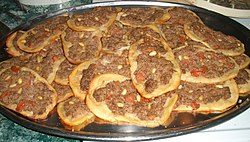 | |
| Alternative names | lahem bi ajin |
|---|---|
| Type | Flatbread |
| Place of origin | Levant |
| Region or state | Syria, Egypt, Jordan, Lebanon and Brazil |
| Main ingredients | Ground mutton |
Sfiha or sfeeha (Arabic: صفيحة, romanized: ṣafīḥa) is a dish consisting of flatbread cooked with a minced meat topping, often lamb flavored with parsley, onion, tomato, pine nuts, and spices. It is traditionally found in the countries of the Levant, and is closely related to manakish and lahmacun.
Sfiha has become popular in parts of South America, where it is known as esfiha or esfirra in Brazil or as sfija in Argentina, after being introduced by Middle Eastern immigrants to the former and to the latter from Syria and Armenia.
History
Flatbreads have been present in the Fertile Crescent since prehistoric times. They have been cooked on hot surfaces such as stones, a metal sajj plate, taboon, or tandoor. In the medieval Arab world, with the development of the brick oven or furn, a wide variety of flatbreads baked together with stuffings or toppings emerged, including sfiha, and spread across the Ottoman Empire.
In Brazil, esfiha gained popularity in the late 20th century, and since has become one of the most popular fast foods.
Main ingredients
Every family has their own preference on what to add in addition to the meat. In Lebanon, the main ingredients are: meat, onions, tomatoes, pine nuts, salt, pepper, and flavorings such as cinnamon, sumac, or pomegranate molasses. The region of Baalbek is especially known for its sfiha. In Syria, Palestine, and Jordan, sfiha is similarly made with minced meat or lamb, in addition to herbs and spices, with tomatoes, onions, and other ingredients.
Esfihas in Brazil are oven baked and may be open-faced flatbreads about 4 inches in diameter with meat topping, or folded into a triangular pastry like fatayer. They may have various toppings, including cheese, curd, lamb, beef or vegetables.
See also
References
- ^ The World's Best Street Food: Where to Find it & How to Make it. Lonely Planet. 1 August 2012. ISBN 978-1-74321-664-4 – via Google Books.
- ^ Marks, Gil (17 November 2010). Encyclopedia of Jewish Food. HMH. ISBN 978-0-544-18631-6 – via Google Books.
- "Gramatica atualizada". Dicionario e gramatica. (in Portuguese). 2015-09-27. Retrieved 2021-02-26.
- ^ Karam, John Tofik (14 March 2008). Another Arabesque: Syrian- Brazil. Temple University Press. pp. 127–128. ISBN 978-1-59213-541-7 – via Google Books.
- Saleh, Nada (31 March 2012). New Flavours of the Lebanese Table. Random House. ISBN 978-1-4481-1876-2 – via Google Books.
- "Community profile" (PDF). metrosouth.health.qld.gov.au. Retrieved 2021-02-26.
- Nasser, Christiane Dabdoub (10 July 2013). Classic Palestinian Cuisine. Saqi. ISBN 978-0-86356-879-4 – via Google Books.
- Kalla, Joudie (3 September 2019). Palestine on a Plate: Memories from my mother's kitchen. White Lion Publishing. p. 32. ISBN 978-0-7112-4529-7 – via Google Books.
- Guides, Insight (1 February 2018). Insight Guides Jordan (Travel Guide eBook). Apa Publications (UK) Limited. ISBN 978-1-78671-396-4 – via Google Books.
- Roberts, Yara Castro (2 May 2009). The Brazilian Table. Gibbs Smith. p. 186. ISBN 978-1-4236-0814-1 – via Google Books.
| Lebanese cuisine | |
|---|---|
| Beverages | |
| Breads | |
| Meze | |
| Cheeses | |
| Soups | |
| Dishes | |
| Grilled meats | |
| Desserts | |
| Frequent ingredients | |
| Unique instruments | |
| Related cuisines | |
This Brazilian cuisine–related article is a stub. You can help Misplaced Pages by expanding it. |